Things to know about home care logistics and documentation: Medication and materials
Specialist topics
Things to know about home care logistics and documentation: Medication and materials
Smoothly running home care logistics and documentation are indispensable components of optimal client care. It is not uncommon for several doctors to be involved and to prescribe different medications, especially in the case of various types of complaints. It is then very important to keep an eye on all possible side effects, interactions and secondary illnesses.

Of course, this also applies to the correct dosages and times of intake. It is essential to analyze and optimize the individual processes so that clients are not confronted with uncertainties on a daily basis. Models for integrated medication supply are needed.
This challenge was analyzed in more detail in 2008 as part of a project entitled "Integrated medication supply". The aim was to develop new approaches to improve the safety and efficacy of medicines in the outpatient sector.
The basics of the "Integrated Medication Supply" project

25 polymorbid patients took part in this project. On average, they were treated by up to five different doctors and had been hospitalized at least once in the previous year. Their complaints were wide-ranging and ranged from heart disease to spinal injuries and renal insufficiency.
The participating patients not only complained about the large number of medications they had to take. The lack of overview they had of their medication was also an important issue. Other fears mentioned were:
- Fear of side effects
- Uncertainty about interactions between different medications
- previously unknown intolerances
There were also complaints about logistics, as medication had to be collected and stored properly at home. This represents a significant additional expense for patients. The doctors who were interviewed as part of this project also expressed concerns. Among other things, they complained about the high complexity of certain treatments and the associated fear of unknowingly making mistakes.
The reason for this is the information vacuum that arises when a patient is treated by several doctors. They do not always exchange sufficient information with each other. This makes it very difficult to coordinate treatment methods. It was not uncommon for additional treatments to be necessary because side effects remained unrecognized or contraindications were present.
What progress has Spitex logistics made in recent years thanks to the project?
Based on the challenges outlined above, a program was launched to achieve several goals at once. For example, it was to create more transparency regarding medication for all those involved in order to optimize information and material flows. This would also increase medication safety.
To this end, it was examined whether electronic prescription systems that would enable data networking and coordinated material flows between doctors could be implemented in a meaningful way. Doctors, insurers, care units such as Spitex organizations and a pharmacy were involved. They were all given the tasks to which they were entitled.
The insurers took the first step. They contacted their clients and asked them to take part in the project subject to strict quality controls. The pharmacy then took over and entered the medication data from the last twelve months into its system. It also contacted the patients again to ask them about their lifestyle habits and health data.
All the data collected was systematically structured. The units providing care were then consulted and asked for further relevant information regarding the medications. This was followed by intensive inter-physician pharmaceutical checks, which focused on identifying any duplicate prescriptions, contraindications and economic alternatives.
The attending physicians were then involved. This was followed by discussions on whether certain medications could be dispensed with and which dosages should be adjusted. The optimization of ordering rhythms and pack sizes, cheaper generics and simple therapeutic substitutions were also discussed.
The results of the "Integrated medication supply" project at a glance
The project provided valuable insights. For example, close cooperation between doctors and pharmacists is a key prerequisite for making medications for polymorbid patients safer. IT is also of particular importance. Keeping track of the large amount of patient data manually and passing it on is a mammoth task that can hardly be accomplished.
IT-supported processes are therefore required, such as the electronic prescription or the electronic patient dossier. Ideally, the latter is stored in a central location, but can still be viewed at any time by authorized doctors, caregivers and pharmacists.
In addition, there are precise medication schedules that clearly show which medication should be taken at what time of day. It also provides information on how the medication should be taken, why it was prescribed and who prescribed it. Information on optimal storage should also be included.
Just two years after the project, the improvement in medication safety and cost-effectiveness was clearly visible.
How important are medication plans in home care logistics and how can they be improved?

The medication plans already briefly mentioned are a very important point in the context of Spitex logistics and documentation. The IG eMediplan is dedicated to this, among other things. Its aim is to establish comprehensive, structured and always up-to-date medication plans in client care.
The eMediplan should develop into a useful and reliable working tool that is accessible to all healthcare professionals and clients involved. The aim is to make drug therapies more effective, safer and more efficient. The basic idea of the eMediplan enjoys broad acceptance and is one of the most important applications of the electronic patient dossier.
Numerous Spitex organizations, hospitals, doctors' surgeries, pharmacies and inpatient care facilities have already implemented an interface in their primary software. This allows them to at least read in and print out the eMediplan. An app is also available, allowing clients to access their data anytime and anywhere.
The eMediplan in focus
The eMediplan provides information on the most important medical data such as age, weight, height, allergies and insufficiencies. This makes it easier for everyone involved to assess the medication. This is very easy for the client to identify, as the plan contains pictures as well as the names. This means that medication cannot be confused.
There is also clear information on what time of day which medication should be taken and in what quantity. There are also instructions on how to take the medication. The eMediplan also provides information on why the medication should be taken and who prescribed it.
As soon as changes are prescribed, the plan is adjusted immediately so that no mistakes are made. It also features a QR code that contains all the information in digital form. Healthcare professionals can scan it and clients can scan it with the Mediplan app.
All this makes the eMediplan the ideal basis for collaboration between all those involved. It facilitates communication immensely and enables precise coordination. It gives clients a high degree of security. It minimizes the risk of taking medication incorrectly, forgetting it or mixing it up.
A major advantage for healthcare is that the eMediplan minimizes costs. Thanks to optimized medications, there are hardly any overdoses or double prescriptions.
The problem of double medication

Double medication in particular is a major problem, which is of course not only a burden on healthcare, but also on the clients themselves. It is striking that Spitex clients often take more medication than nursing home residents. On average, Spitex clients take 16 different medications at the same time. In contrast, the average for nursing home residents is only nine.
This amount is often not even necessary. Once again, the reason for this is the lack of information transfer between the various doctors providing treatment. If they do not know what other doctors have already prescribed, they may issue another prescription. Such duplicate prescriptions are not always obvious to clients. There are numerous medications that have different names and appearances but contain the same active ingredients.
However, this is by no means the fault of Spitex. The specialists working there do not prescribe medication. The problem lies more in the fact that the various doctors treating the clients often know nothing about each other.
Finding the right Spitex made easy
Are you looking for a Spitex where you can be sure of comprehensive care? With just a few clicks, you'll find what you're looking for at OPAN®. We will ensure that your relative receives exactly the support they need. Get in touch with us!
